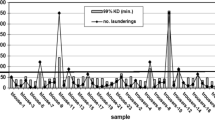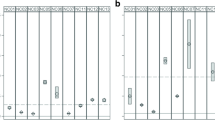Abstract
Personal protective measures against hematophagous vectors constitute the first line of defense against arthropod-borne diseases. In this regard, a major advance has been the development of residual insecticides that can be impregnated into clothing. Currently, however, information on specific treatment procedures, initial insecticide concentrations, arthropod toxicity, residual activity, and laundering resistance is either fragmentary or non-existent, and no World Health Organization Pesticides Evaluation Scheme or other guidelines exist for the standardized testing and licensing of insecticide-treated clothing. The aim of this study was to analyze the insecticide content, contact toxicity, laundering resistance, and residual activity of five commercially available and commonly used permethrin-treated fabrics—Insect Shield, ExOfficio, Sol’s Monarch T-shirts, battle dress uniforms (BDUs), and Labonal socks—against vector-competent Aedes aegypti, Anopheles stephensi, and Culex pipiens mosquitoes under laboratory conditions. Prior to laundering, permethrin concentrations ranged from 4300 to 870 mg/m2 whereas, after 100 defined machine launderings, the remaining permethrin content fell to between 1800 and 20 mg/m2, a percentage permethrin loss of 58.1 to 98.5 %. The highest 99 % knockdown (KD99) efficacy of permethrin was detected in Ae. aegypti, followed by An. stephensi and Cx. pipiens demonstrating that Ae. aegypti is the most sensitive species and Cx. pipiens the least sensitive. After 100 launderings, the remaining biocidal efficacy differed markedly among the five brands, with KD99 times varying from 38.8 ± 2.9 to >360 min for Ae. aegypti, from 44 ± 3.5 to >360 min for An. stephensi, and from 98 ± 10.6 to >360 min for Cx. pipiens. Overall, the ranking of the residual biocidal efficacies within the five brands tested was as follows: BDU ≈ Labonal > Sol’s Monarch > ExOfficio > Insect Shield. When applying German Armed Forces licensing conditions, none of the four products available in the civilian market would completely meet all the necessary efficacy and safety requirements fulfilled by BDUs. Therefore, we strongly recommend standardized testing and licensing procedures for insecticide-treated clothing, with defined cutoff values for initial maximum and post-laundering minimum concentrations of permethrin as well as figures for permethrin migration rates, arthropod toxicity, homogeneity on fabrics, residual activity, and laundering resistance.







Similar content being viewed by others
References
Appel KE, Gundert-Remy U, Fischer H, Faulde M, Mross KG, Letzel S, Rossbach B (2008) Risk assessment of Bundeswehr (German Federal Armed Forces) permethrin-impregnated battle dress uniforms (BDU). Int J Hyg Environ Health 211:88–104
Banks SD, Murray N, Wilder-Smith A, Logan JG (2014) Insecticide-treated clothes for the control of vector-borne diseases: a review on effectiveness and safety. Med Vet Entomol 28(S1):14–25
Buczek A, Lachowska-Kotowska P, Bartosik K (2015) The effect of synthetic pyrethroids on the attachment and host-feeding behavior in Dermacentor reticulatus females (Ixodida: Amblyommidae). Parasit Vectors 8:366
Burgess NR, Carter SW, Dodd GD, Shirley CD (1988) Permethrin fabric treatments for the protection of personnel from biting insect and other arthropod attack. Intern Pest Control 30:142–144
Carnevale P, Mouchet J (1997) La protection individuelle contre les insectes vecteurs. Med Trop 57:505–510
Darriet F, Robert V, ThoVien N, Carnevale P (1984) Evaluation of the efficacy of permethrin-impregnated intact and perforated mosquito nets against vectors of malaria. World Health Organization, Geneva, Switzerland, WHO/VBC/84.899: 19
Evans SR, Korch GW Jr, Lawson MA (1990) Comparative field evaluation of permethrin and DEET-treated military uniforms for personal protection against ticks (Acari). J Med Entomol 27:829–834
Faulde M, Uedelhoven W (2006) A new clothing impregnation method for personal protection against ticks and biting insects. Int J Med Microbiol 296(1):225–229
Faulde MK, Uedelhoven WM, Robbins RG (2003) Contact toxicity and residual activity of different permethrin-based fabric impregnation methods for Aedes aegypti (Diptera: Culicidae), Ixodes ricinus (Acari: Ixodidae), and Lepisma saccharina (Thysanura: Lepismatidae). J Med Entomol 40:935–941
Faulde MK, Uedelhoven WM, Malerius M, Robbins RG (2006) Factory-based permethrin impregnation of uniforms: residual activity against Aedes aegypti and Ixodes ricinus in battle dress uniforms worn under field conditions, and cross contamination during the laundering and storage process. Mil Med 171(6):472–477
Faulde M, Scharninghausen J, Tisch M (2008) Preventive effect of permethrin impregnated clothing for humans exposed to Ixodes ricinus ticks and associated Borrelia burgdorferi s.l. in Germany. Int J Med Microbiol 298(S1):321–324
Faulde M, Albiez G, Nehring O (2012) Novel long-lasting impregnation technique transferred from clothing to bednets: extended efficacy and residual activity of different pyrethroids against Aedes aegypti as shown by EN ISO 6330-standardized machine laundering. Parasitol Res 110(6):2341–2350
Faulde MK, Rutenfranz M, Keth A, Hepke J, Rogge M, Görner A (2015) Pilot study assessing the effectiveness of factory-treated, long-lasting permethrin-impregnated clothing for the prevention of tick bites during occupational tick exposure on military training areas, Germany. Parasitol Res 114(2):671–678
Fryauff DJ, Shoukry MA, Hanafi HA, Choi YM, Kamel KE, Schreck CE (1996) Contact toxicity of permethrin-impregnated military uniforms to Culex pipiens (Diptera: Culicidae) and Phlebotomus papatasi (Diptera: Psychodidae): effects of laundering and time of exposure. J Am Mosq Control Assoc 12:84–90
Hoffmann G (1995) Wirkung, Einsatzgebiete und Erfordernis der Anwendung von Pyrethroiden im nicht-agrarischen Bereich. Bundesgesundheitsblatt 38:294–303
International Organization for Standardization (ISO) (2009) Domestic washing and drying procedures for textile testing. EN ISO 6330:2000, amended 2009. Available from www.iso.org
Londono-Renteria B, Patel JC, Vaughn M, Funkhauser S, Ponnusamy L, Grippin C, Jameson SB, Apperson C, Mores CN, Wesson DM, Colpitts TM, Meshnick SR (2015) Long-lasting permethrin-impregnated clothing protects against mosquito bites in outdoor workers. Am J Trop Med Hyg 93:869–874
Pennetier C, Chabi J, Martin T, Chandre F, Rogier C, Hougard JM, Pagès F (2010) New protective battle-dress impregnated against mosquito vector bites. Parasit Vectors 3:81
Schreck CE, Posev K, Smith D (1978) Durability of permethrin as a potential clothing treatment to protect against blood-feeding arthropods. J Econ Entomol 71:397–400
Schreck CE, Mount GA, Carlson DA (1982) Pressurized sprays of permethrin on clothing for personal protection against the lone star tick (Acari: Ixodidae). J Econ Entomol 75:1059–1061
US Armed Forces Pest Management Board (2009) Technical Guide No. 36: Personal protective measures against insects and other arthropods of military significance. Available from http://www.afpmb.org/sites/default/files/pubs/techguides/tg36.pdf
Vaughn MF, Meshnick SR (2011) Pilot study assessing the effectiveness of long-lasting permethrin-impregnated clothing for the prevention of tick bites. Vector Borne Zoonotic Dis 11:869–875
Vaughn MF, Funkhouser SW, Lin F-C, Fine J, Juliano JJ, Apperson CS, Meshnick SR (2014) Long-lasting permethrin impregnated uniforms: a randomized-controlled trial for tick bite prevention. Am J Prev Med 46:573–480
WIWeB (2014) Bedingungen für die Zulassung der Vektorenschutzausrüstung gemäß TL 8305–0331. Available from www.baainbw.de/resource/resource/MzEzNTM4MmUzMzMyMmUzMTM1MzMyZTM2MzEzMDMwMzAzMDMwMzAzMDY5MzM3MzZkMzY3NTZkNzUyMDIwMjAyMDIw/Zulassungsbedingungen_Vektorenschutz_7_15.12.14.pdf TL 8305–0331
World Health Organization (2001a) Vectors of diseases: hazards and risks for travellers—part I. WER 25:189–194
World Health Organization (2001b) Vectors of diseases: hazards and risks for travellers—part II. WER 26:201–203
World Health Organization (2013) Guidelines for laboratory and field-testing of long-lasting insecticidal nets. http://apps.who.int/iris/bitstream/10665/80270/1/9789241505277_eng.pdf
Yao TT, Wang LK, Cheng JL, Hu YZ, Zhao JH, Zhu GN (2015) Optimization of pyrethroid and repellent on fabrics against Stegomyia albopicta (=Ades albopictus) using a microencapsulation technique. Med Vet Entomol 29:37–43
Young D, Evans S (1998) Safety and efficacy of DEET and permethrin in the prevention of arthropod attack. Mil Med 163(5):1–7
Zimmer J, Faulde M (2009) Biomonitoring in the German armed forces: focusing on risk assessments during deployments. Clin Chem Lab Med 47:A42–A43
Zimmermann M, Höcker H (1988) Untersuchungen zur Mottenschutzausrüstung von Wolle mit Permethrin. Melliand Textilber 69:909–915
Acknowledgments
The authors thank Ms. Anke Crecelius and Mr. Bernd Bocklet for laboratory support. Dr. Richard G. Robbins, Armed Forces Pest Management Board, Office of the Assistant Secretary of Defense for Energy, Installations and Environment, Washington, DC, helpfully reviewed and commented on an earlier version of our manuscript.
Author information
Authors and Affiliations
Corresponding author
Ethics declarations
Conflict of interest
The authors declare that there are no conflicts of interest.
Rights and permissions
About this article
Cite this article
Faulde, M.K., Pages, F. & Uedelhoven, W. Bioactivity and laundering resistance of five commercially available, factory-treated permethrin-impregnated fabrics for the prevention of mosquito-borne diseases: the need for a standardized testing and licensing procedure. Parasitol Res 115, 1573–1582 (2016). https://doi.org/10.1007/s00436-015-4892-2
Received:
Accepted:
Published:
Issue Date:
DOI: https://doi.org/10.1007/s00436-015-4892-2




